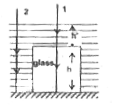Two beams of light are incident normally on water (R.l. = 43). If the beam 1 passes through a glass (R.l. = 32) slab of height h as shown in the figure, the time difference for both beams for reaching the bottom is

zero
h′6C
6hC
h6C
The correct Answer is:D
Step by step video & image solution for Two beams of light are incident normally on water (R.l. = 4/3). If the beam 1 passes through a glass (R.l. = 3/2) slab of height h as shown in the figure, the time difference for both beams for reaching the bottom is by Physics experts to help you in doubts & scoring excellent marks in Class 12 exams.
Updated on:21/07/2023Topper's Solved these Questions
- RAY OPTICS AND WAVE OPTICS BOOK - VMC MODULES ENGLISHCHAPTER - RAY OPTICS AND WAVE OPTICS EXERCISE - IMPECCABLE
58 Videos
- RAY OPTICS AND WAVE OPTICS BOOK - VMC MODULES ENGLISHCHAPTER - RAY OPTICS AND WAVE OPTICS EXERCISE - ENABLE
50 Videos
- RAY OPTICS BOOK - VMC MODULES ENGLISHCHAPTER - RAY OPTICS EXERCISE - IN-CHAPTER EXERCISE-J
10 Videos
- REVISION TEST-15 JEE - 2020BOOK - VMC MODULES ENGLISHCHAPTER - REVISION TEST-15 JEE - 2020EXERCISE - PHYSICS
25 Videos
Similar Questions
Two parallel beams of light P and Q are incident normally on a prism and the transmitted rays are brought to focus with the help of a convergent lens as shown in Fig. 2.23. If the intensities of the upper and lower beams immediately after transmission from face AC are 4I abd I, respectively, find the resultant intensity at the focus.
View SolutionA laser beam propagates through a spherically symmetric medium, as shown in the figure. The refractive index varies with the distance to the symmetry centre C by the law μ(r)=μ0rr0, where μ0=1, r0=3cm, r0≤r<∞. The beam's trajectory lies in the plane that includes C. At distance r1=8√2cm the beam makes an angle ϕ=30∘ with →r1 as shown in the figure. Find the minimum distance (in cm) the beam reach relative to the symmetry centre C.

View SolutionTwo parallel rays are travelling in a medium of refractive index μ1=4/3. One of the rays passes through a parallel glass slab of thickness t and refractive index μ2=3/2. The path difference between the two rays due to the glass slab will be
View SolutionA massless beam of langth 5 m is placed on two wedges A and B. If three forces 3 kN, 4 kN and 5 kN are applied on the beam as shown in the figure, then find normal reaction at A and B.

View SolutionA parallel beam of light is incident normally on the flat surface of a hemisphere of radius 6cm and refractive index 1.5, placed in air as shown in figure (i). Assume paraxial ray approxiamtion.
 .
.
View SolutionLight passes through a rectangular glass slab and through a triangular glass prism. In what way does the direction of the two emergent beams differ and why?
View Solution
A diverging beam of light from a point source S having devergence angle α, falls symmetrically on a glass slab as shown. The angles of incidence of the two extreme rays are equal. If the thickness of the glass slab is t and the refractive index n, then the divergence angle of the emergent beam is
View SolutionA beam of light falls on a glass plate (μ=3/2) of thickness 6.0 cm at an angle of 60∘. Find the deflection of the beam on passing through the plate. (in cm).
View SolutionA beam of light from the point A(3,10) reflects from the line 2x+y−6=0 and then passes through the point B(5, 6).The equation of reflected beam is :
View SolutionA beam of light from the point A(3,10) reflects from the line 2x+y−6=0 and then passes through the point B(5, 6).The equation of reflected beam is :
View Solution
